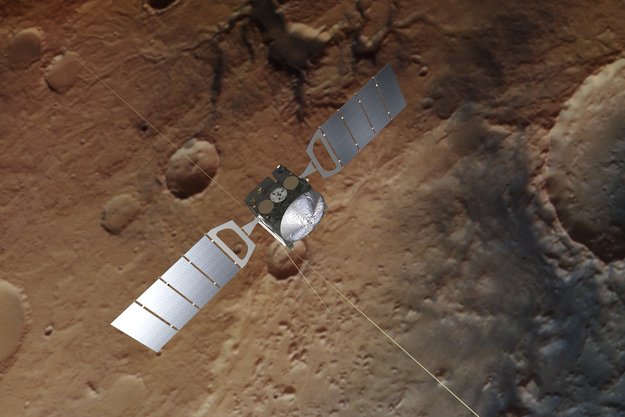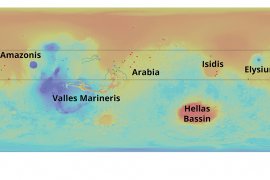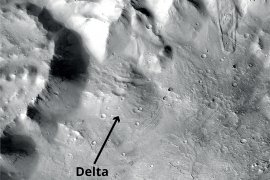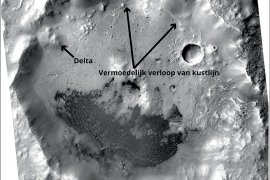Geologic evidence for extensive ground water system on Mars
Utrecht University geologist Francesco Salese studied 24 low-lying areas distributed around the northern hemisphere of Mars. Satellite images have provided evidence of large volumes of simultaneous ground water activity connecting the areas. Salese has also found remains of deltas and coastlines on the planet’s surface. “These are strong indications that water was once present in these dried-up basins. There is no evidence that they had been filled from the surface, so upwelling ground water is the only remaining explanation. The deltas are all located at approximately the same elevation, so we are probably dealing with a ground water reservoir that spans the entire planet.”

Other researchers, including some at Utrecht University, have predicted the presence of ground water on Mars since 2010. Until now, however, they were unsure as to whether the water was located in local ground water basins, or if it was a extensive system of interconnected basins, because the models and available evidence indicated that both answers were possible. Now, Salese has proven that the basins are indeed interconnected, and spread over a large area of the planet. But what happened to all of the water in those basins? “That’s the big question. We’ve been able to determine that the ground water system we’ve discovered dates from around 3.5 billion years ago, but we don’t know when or how the basins dried up. The same applies to the other structures on the planet’s surface that indicate water must have flowed over the surface at some point.”
Some time later in the planet’s history, the groundwater on Mars froze into permafrost. At that point, the water activity was limited to isolated areas around local and short-lived heat sources. “Think of phenomena like meteorite impacts or volcanic eruptions.”
Studying evidence
Half of the basins had been studied before, but only on an individual basis, and the emphasis in those studies was mainly on the mineralogy of the sites. Salese examined how the 24 basins were interconnected, and included the locations’ hydrology - the presence and behaviour of water - in his research. All of the basins are located between the planet’s equator and 37° north latitude. Why did he focus specifically on that region? “The presence of water in more northerly regions could have led to the creation of glaciers, and the traces of glaciers are more difficult to study. The region south of the 37th parallel presents more opportunities to examine the hydrological morphology - how water affects the formation of the landscape.”
As far as we know Mars should be considered a one-plate-planet. The substrate is so much simpler than the Earth’s, that it is possible to have a huge ground water system
Plates and volcanoes
A Mars-wide ground water system assumes the presence of a stable and rather uniform substrate, because otherwise it would be impossible to feed so many water basins located so far away from one another. Support for that theory is provided by earlier structural geological research. “The substrate is so much simpler than the Earth’s, that it is possible to have a huge ground water system. Because as far as we know Mars should be considered a one-plate-planet.” The height of the volcanoes on Mars provides additional evidence for that hypothesis. “They reach up to 21 kilometres high, not only because gravity is weaker on Mars, but also because the volcanoes have been active for an extremely long period of time at the same location. And that would only be possible if they hadn’t been disturbed by tectonic plates sliding beneath them, such as the case in Hawaii where a chain of volcanoes formed because of the moving plate.”
Research on Mars mainly teaches us about the red planet itself, but the research may be important for the future of our planet as well.
Importance for Earth
In the first instance, research on Mars mainly teaches us about the red planet itself. “For example, in 2013 and 2019, researchers found mineralogical evidence for circumstances that could be beneficial for the presence of life in some of the basins.” But the research may be important for the future of our own planet as well. “As we learn more about water on Mars, especially the reason why we see so little of it on the planet today, we may be able to find out if the same can happen to Earth, or if it had already happened when Earth was still very young.”
Geologist Francesco Salese grew up in Italy. In 2018, after obtaining an European PhD at Università d'Annunzio in Pescara (Italy) and Université de Nantes (France), he came to Utrecht with a Marie Curie Individual Fellowship to conduct hydrogeological research. The digital elevation model and images he used for his study were taken with the High Resolution Stereo Camera on board the European Mars Express Orbiter.
Utrecht University’s research on water on Mars is explained in greater detail in this video.




